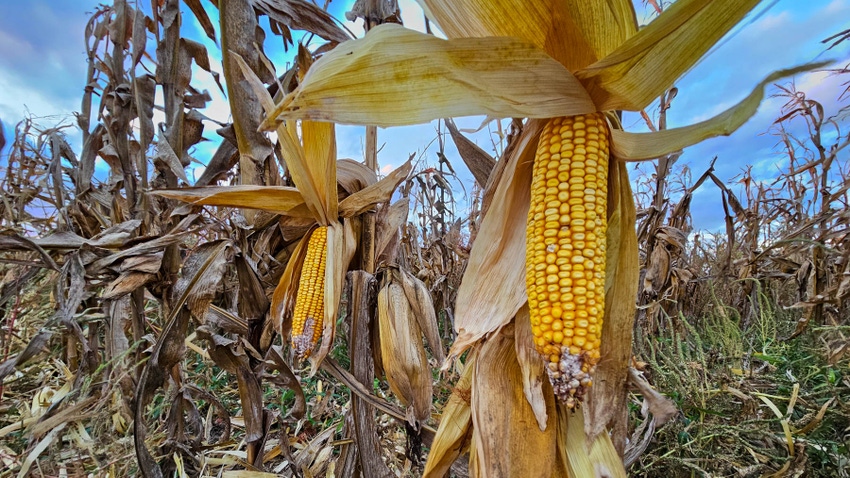
Kenny Rathjen says he learns a lot from participating in the National Corn Growers Association’s annual yield contest.
“It takes a little time to measure everything out and make certain it’s precise,” he says. “But we learn from one year and change for the next.
“We’ve participated for several years and got first in the state several times.”
In 2023 Kenny’s dad, Richard, got top yield in Oklahoma in the No-till Irrigated category with 380 bushels per acre with Pioneer P1572AM hybrid. That yield was good for second in the nation for that category.
Kenny manages the Cimarron County Oklahoma farm for his dad, who minds the home farm in South Dakota.
“I manage the farms in Oklahoma and Texas,” Kenny says. “I also partner some with my dad and farm some on my own.” Kenny’s 308 bushel yield in 2023 was second in the Strip-Till, Minimum-Till, Mulch-Till, Ridge-Till, Irrigated class in Oklahoma. He planted Pioneer P1828Q.
He also participates and the National Sorghum Producers yield contest and has done well there, too.
Strive to do better
“We strive to do better and change all the time. We started panning for 2024 as soon as we finished combining.”
Rathjen says the circle with the contest yield benefited from a lot of fertilizer.
“We planted behind terminated wheat we had planned to chop for silage. We didn’t like the stand, so we took prevented planting on it and changed to corn. We had applied 130 pounds of urea on the wheat.
“We killed the wheat at 6 to 8 inches high and fertilized corn like any other year because we did not know how much we had left from the wheat. We knew it had used a little nitrogen.”
He says they probably had as much as 440 units of nitrogen on the corn.
First no-till
That was also the first no-till corn crop. “We usually conventional till or strip till. But when we sprayed the wheat and killed it, we decided to no-till. For a long time in the spring our black ground was ahead of the no-till. Black land warmed faster. For the longest time, the no-till didn’t’ t move, so we added fertilizer.
“The cover crop helped,” he says. “We will do more of that this year, maybe a couple more circles like that. We plan to plant behind wheatlage this year, no-till P1572AM into that. Planting behind wheat worked well and I like the P1572AM in that system.”
He plants some circles in conventional or strip till. “We will have one circle of strip till in Oklahoma and two in no-till; others will be in conventional. In Texas, we will use no-till and strip till.”
Wheat cover crop
He prefers wheat as a cover crop. “A lot of people use cereal rye, but if we have to spend money to irrigate, it doesn’t pay. With a limited water supply, we can only pump so much.
“Last year, the guy who chops and buys our wheat used a helicopter to look at stands of wheat. We found two that didn’t look good. So, instead of cutting four circles last year, we cut two and abandoned two. Other than that, we no-till behind the chopper unless it’s too wet and we have to strip till.”
Wet spring
Last year was a bit unusual. “We didn’t plan to use that much fertilizer,” Rathjen says. “We air-seeded and spread urea on the wheat. When we decided to abandon it, we had carryover in the corn crop.”
Rathjen says yields across the circle averaged 300 bushels per acre.
He says rotation depends on the year. “Last spring was wet and cool, which pushed things back. We had two circles of prevent-planted wheat. Wheat planted for hay worked out well. We had three circles of corn up here and also some near Dalhart, Texas. We also planted sorghum silage.
“The wet spring changed things a lot, but all that rain carried the moisture profile through year. We caught 2.5 inches of rain when we were about to turn the sprinklers off. That added test weight.”
Fungicide management
Fungicide management changed a bit for 2023, too. “I applied a half rate three weeks before tassel and a full rate at tassel. That paid off. I’m a firm believer in fungicides, but I do not usually apply it twice.”
Rathjen’s cropping system consists of corn, wheat, and milo. He plans to plant milo on a farm he bought two years ago in Dallam County Texas. “I broke out a 50-acre circle last year with corn silage and planted P1572AM. I’ll plant milo this year. I hope to go big in the Sorghum Producers yield contest with that. It has been manured twice, so it should raise an awful good crop.”
More corn
Corn looks good this year. “I will plant a little more corn,” Rathjen says. “Last year’s prevented planting is uncommon for here. Around Dalhart, they get 20-plus inches of rain. Here, we got 10.5 during the growing season. We irrigate everything. In Oklahoma, we farm five circles, 625 acres; we have 200 around Dalhart, another 500 west and 300 east of Dalhart.”
Rathjen is optimistic about 2024. “It’s been raining all morning today (Jan. 28), and we had 13 inches of snow two weeks ago and 6 inches before that. It’s setting up to be a good year.”
Read more about:
YieldsAbout the Author(s)
You May Also Like






